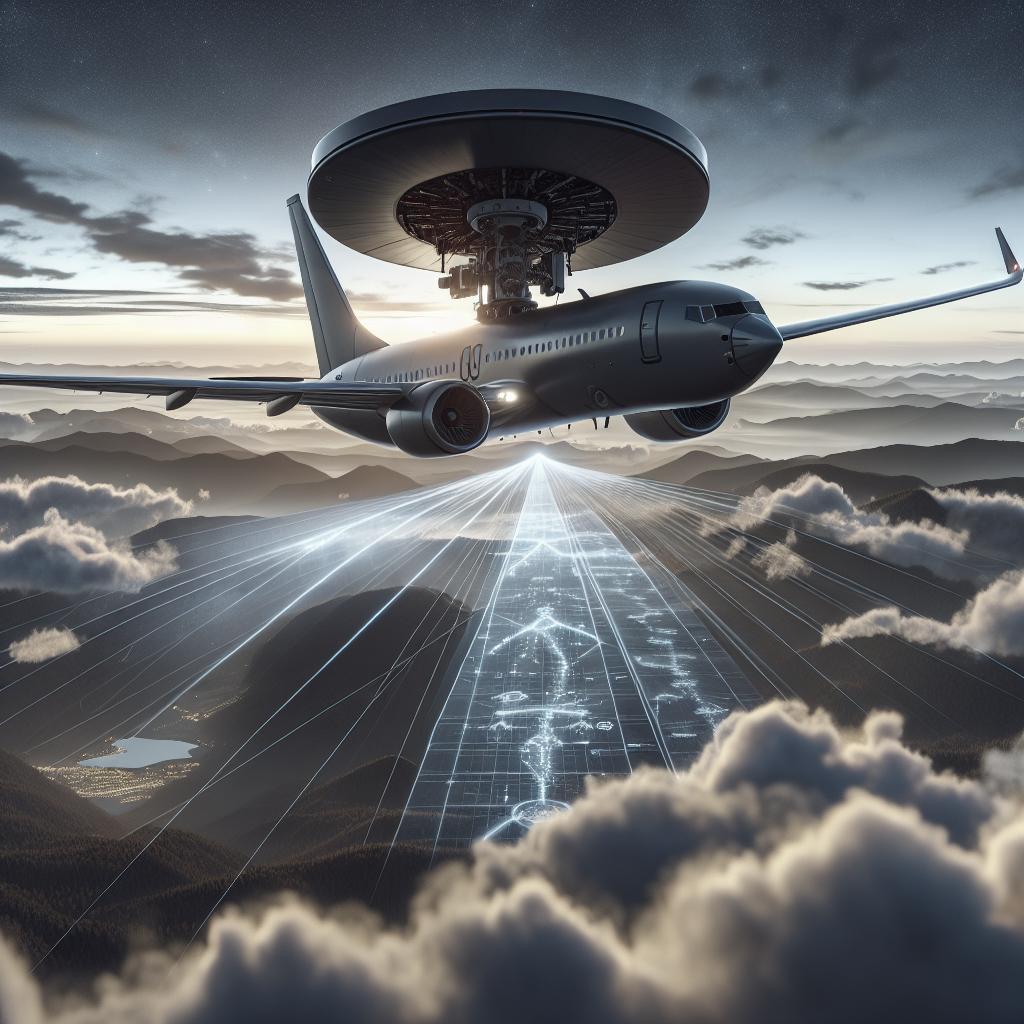Are you fascinated by how surveillance airplanes maintain their awareness of the skies, detect potential issues, and enhance safety for both aircraft and ground control? The secret lies largely in radar technology. This article delves into the various functions of radar on surveillance airplanes, providing a detailed overview of its critical roles. From comprehending the basic principles of radar to exploring the advancements and future innovations, you’ll gain a comprehensive understanding of how radar contributes to aviation safety, efficiency, and security. We’ll also touch on other radar applications, such as in-ground systems, weather navigation, and airport runway safety. Read on to uncover the integral role radar plays in modern aviation.
Comprehending Radar
Radar, an acronym for Radio Detection and Ranging, is a system that uses radio waves to determine the distance, angle, and velocity of objects. The basic principle involves transmitting a radio signal and measuring the time it takes for the signal to return after reflecting off an object. By analyzing the return signal, radar systems can determine an object’s position and movement. Surveillance airplanes rely on radar systems to monitor airspace, detect other aircraft, and provide real-time data to pilots and air traffic controllers. The technology is crucial for maintaining a safe and efficient airspace, offering precise information about the location and speed of surrounding aircraft and potential obstacles.
Ground-Based Radar Systems
Ground-based radar systems are among the earliest applications of radar technology. These systems provide continuous monitoring of airspace, covering large areas and tracking multiple aircraft simultaneously. Ground control stations receive real-time data from these radar systems, enabling them to manage air traffic effectively. Radar systems on the ground have evolved significantly, with advancements in technology leading to more accurate and reliable data. Enhanced radar systems can now distinguish between different types of objects, reducing the likelihood of false alarms and improving overall airspace safety.
Identifying Aircraft Position
One of the primary functions of radar on surveillance airplanes is to identify the position of other aircraft. Through constant scanning and tracking, radar systems provide precise data on the location, altitude, and speed of nearby planes. This information is crucial for maintaining safe distances between aircraft and preventing mid-air collisions. Modern radar systems also integrate with secondary radar, which requires aircraft to be equipped with transponders that respond to interrogation signals from the radar. This system, known as Secondary Surveillance Radar (SSR), provides enhanced accuracy and additional data, such as the aircraft’s altitude and identity.
Preventing Collisions
Radar technology is instrumental in collision avoidance. By continuously monitoring the airspace and detecting potential hazards, radar systems can alert pilots and air traffic controllers to potential conflicts. This early warning system allows for timely actions to be taken to avoid collisions and maintain safe flying conditions. In addition to onboard radar systems, ground-based radar also plays a crucial role in collision prevention. By providing comprehensive tracking of all aircraft within a specific airspace, ground-based radar helps ensure that air traffic controllers have the information they need to manage airplane movements effectively and avoid dangerous situations.
Assisting Air Traffic Control
Radar systems play a pivotal role in air traffic control, providing real-time information to controllers who manage the flow of aircraft within their designated airspace. The data from radar systems allow controllers to monitor aircraft movements, manage take-offs and landings, and ensure safe and efficient air traffic flow.
air−traffic control
In addition to aiding with general air traffic management, radar systems help air traffic controllers handle complex situations, such as guiding aircraft through congested airspace, managing diversions due to bad weather, or coordinating search and rescue operations. The integration of radar data into air traffic control systems is essential for maintaining the safety and efficiency of the aviation industry.
Navigating Safely Through Weather
Weather conditions can significantly impact flight safety and efficiency. Radar systems on surveillance airplanes provide critical information about weather patterns, helping pilots navigate safely through adverse conditions. Weather radar can detect precipitation, turbulence, and other hazardous weather phenomena, allowing for timely adjustments to flight paths. Advanced weather radar systems can also provide three-dimensional views of weather patterns, giving pilots a more comprehensive understanding of their environment. This enhanced awareness helps in making informed decisions and avoiding potentially dangerous weather conditions.
Enhancing Safety on Airport Runways
Radar systems are not limited to aerial navigation; they also play a crucial role in enhancing safety on airport runways. Ground radar systems monitor aircraft and vehicle movements on runways and taxiways, preventing collisions and ensuring smooth operations. These systems provide real-time data to air traffic controllers, allowing for better coordination and management of airport activities. Additionally, ground radar systems can detect foreign objects on runways, which can pose severe risks to aircraft during takeoff and landing. By identifying and removing these hazards, radar technology contributes to overall runway safety and reduces the risk of accidents.
Impact of Advancements in Radar Technology
Advancements in radar technology have significantly improved its accuracy, reliability, and functionality. Modern radar systems use advanced signal processing techniques, higher frequency bands, and refined detection algorithms to provide more detailed and accurate information. These improvements have enhanced the ability of radar systems to distinguish between different types of objects and reduce false alarms. The integration of radar data with other technologies, such as satellite navigation systems and automated air traffic management systems, has further enhanced its capabilities. This synergy allows for more comprehensive monitoring and management of airspace, leading to increased safety and efficiency in aviation operations.
Upcoming Innovations
The future of radar technology in aviation looks promising, with several advancements on the horizon. Emerging technologies such as Phased Array Radar, which uses multiple tiny antennas to scan the sky quickly and accurately, are set to revolutionize radar systems in surveillance airplanes. This technology promises faster processing times and more detailed information, enhancing situational awareness for pilots and air traffic controllers. Another exciting development is the integration of Artificial Intelligence (AI) and Machine Learning (ML) with radar systems. These technologies can analyze vast amounts of radar data in real-time, identifying patterns and predicting potential issues before they arise. This proactive approach to radar data analysis will significantly enhance the safety and efficiency of surveillance operations.
Lessons Learned
Radar technology is an indispensable tool in modern aviation, providing critical information for safe and efficient airspace management. From identifying aircraft positions and preventing collisions to assisting air traffic control and navigating through adverse weather, radar systems play a pivotal role in ensuring aviation safety. Advancements in radar technology continue to enhance its capabilities, promising a future of even safer and more efficient skies. Below is a summary table of the topics discussed:
| Topic | Description |
|---|---|
| Comprehending Radar | Understanding the basic principles of radar technology. |
| Ground-Based Radar Systems | The role of radar systems in ground control and air traffic management. |
| Identifying Aircraft Position | Radar’s function in tracking the position, altitude, and speed of aircraft. |
| Preventing Collisions | The importance of radar in collision avoidance and maintaining safe distances. |
| Assisting Air Traffic Control | How radar systems aid air traffic controllers in managing airspace. |
| Navigating Safely Through Weather | The role of radar in detecting and navigating through adverse weather conditions. |
| Enhancing Safety on Airport Runways | Using radar systems to monitor runway activities and prevent collisions. |
| Impact of Advancements in Radar Technology | How technological advancements have improved radar accuracy and reliability. |
| Upcoming Innovations | Future developments in radar technology, including AI and phased array radar. |
Subscribe
Stay informed about the latest developments in radar technology and aviation by subscribing to our newsletter. Don’t miss out on expert insights, industry news, and more! Sign up today and keep your knowledge soaring.


